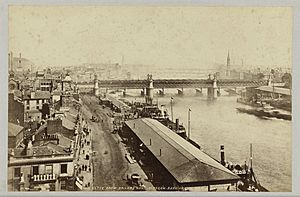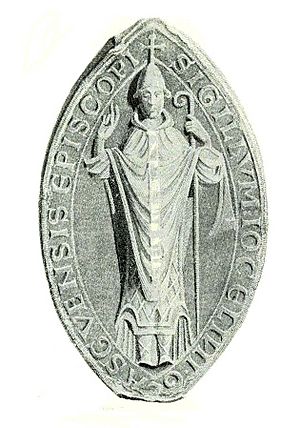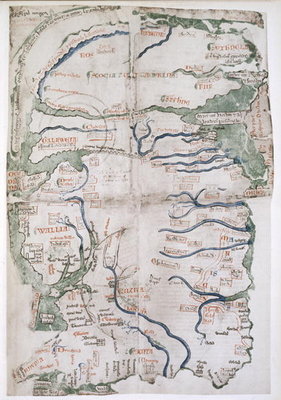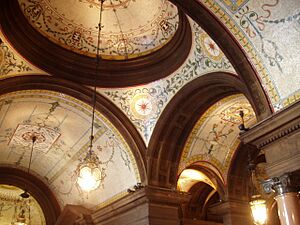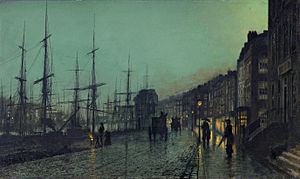History of Glasgow facts for kids
Welcome to the exciting history of Glasgow, a major city in Scotland! This article will take you on a journey through time, showing how Glasgow grew from a small settlement into a bustling, modern city.
Contents
Glasgow's Early Beginnings
People have lived in the area where Glasgow now stands for a very long time. It was a good spot because it was the lowest point on the River Clyde where you could cross it easily. The Romans even built forts nearby, like the Antonine Wall, to protect their lands. You can still see Roman items from these forts in the Hunterian Museum today.
After the Romans left, Glasgow was part of a large kingdom called Strathclyde. This kingdom later joined with others to form the Kingdom of Scotland in the 800s. Glasgow really started to grow in importance in the 900s and 1000s. This was thanks to its role as a major religious center, led by its powerful bishops.
Glasgow Cathedral: A Historic Landmark
By the 1100s, Glasgow was officially recognized as a city. Its grand Glasgow Cathedral became the main church for the Bishops of Glasgow. The first stone cathedral was built around 1136, and a larger one was finished in 1197. Over the centuries, more parts were added to the cathedral. A special window, called the Millennium Window, was added as recently as 1999.
After the Scottish Reformation in 1560, the cathedral changed. Catholic traditions ended, and many statues were removed. The huge cathedral then served three different Protestant churches at the same time! Each part of the building, like the choir and the nave, was used by a different group.
University of Glasgow: A Place of Learning
In 1451, the University of Glasgow was founded. It started in buildings near Glasgow Cathedral. By the 1500s, Glasgow was known as an important city for both religion and education. The university later moved to its own building on High Street.
After 1870, the university became famous worldwide. In 2009, its teaching quality was ranked among the top 10 in Britain. It also gained a strong reputation for its important research.
Glasgow's Rise: Trade and Industry
Atlantic Trade Routes
By the 1500s, Glasgow's skilled workers and traders became very influential. The city was perfectly placed for trade with the Americas because the River Clyde connected it to the sea. However, England's laws, called the Navigation Acts, made it hard for Scottish ships to trade directly with English colonies.
Despite these challenges, Scottish merchants found ways to trade. After Scotland and England united in 1707, trade became legal and boomed. Glasgow became a major port for importing goods like tobacco, cotton, and sugar from the Americas. These goods were then sent all over Europe.
By 1760, Glasgow was the biggest tobacco port in Britain, even bigger than London! The American War of Independence later stopped much of the American trade. So, Glasgow merchants focused more on sugar from the Caribbean. This trade, along with direct involvement in slave ownership, made a group of merchants known as the "Tobacco Lords" incredibly rich. They built grand houses and churches, and invested their money in new industries, helping Glasgow grow even more.
City Improvements and Growth
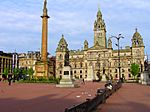
As Glasgow became wealthier, its city center expanded west. Beautiful Victorian architecture buildings, now known as the Merchant City, began to appear. New public buildings like the City Chambers and the Mitchell Library showed off Glasgow's riches in the late 1800s. These grand buildings had fancy interiors and detailed stone carvings.
The city's population grew rapidly. In 1750, there were 32,000 people. By 1850, there were 200,000! City planners started organizing the city better around 1770. However, the growth was so fast that many areas became overcrowded.
Making the Clyde River deeper in the 1770s allowed bigger ships to sail further inland. This was key for Glasgow to become a major industrial and shipbuilding city in the 1800s. The area also had lots of coal and iron, which helped Glasgow become an industrial powerhouse. Factories making textiles (like cotton and wool) became huge employers.
Shipbuilding on the Clyde
By 1893, Glasgow was one of the richest cities in the world. It was even called "the Second City of the Empire" after London. The city built its own public transport system, parks, museums, and libraries.
Shipbuilding on the Clydeside (the banks of the River Clyde) began in 1712. After 1860, the shipyards focused on building steamships made of iron, and later steel. These new ships quickly replaced older wooden sailing ships. Glasgow became the world's leading shipbuilding center. "Clydebuilt" became a sign of top quality, and the shipyards received contracts to build warships for navies around the world.
Textile Industry Boom
In the late 1600s, Scottish linen was a big export to England. By 1680, about 12,000 people in Glasgow worked in the linen industry. Thanks to government support, Glasgow became Britain's largest linen maker by 1770.
However, fashion changed, and people wanted lighter fabrics. Glasgow's textile makers then became experts at producing fine cotton fabrics called muslins. By the 1780s, these muslins were competing with those from India. Textiles, including linen and cotton clothing, were among Scotland's main exports to the American colonies.
From the 1750s, a fashion for silk gauze led to a successful industry in Paisley. Silk gauze was popular with women of all social classes. It couldn't be washed easily, so there was always a demand for new pieces. By the 1780s, Paisley silk gauze was sold across Europe. Later, cotton and muslin became more popular.
Glasgow in the 1900s
The First World War brought many contracts for warships to Glasgow's shipyards. However, many skilled workers left to join the armed forces. During this time, a strong workers' movement called "Red Clydeside" emerged, led by union activists.
The industrial areas of Glasgow, which used to support the Liberal Party, switched to supporting the Labour Party by 1922. This was especially true in areas with a large Irish Catholic working class. Women were also very active in fighting for better housing.
Industry Decline and Post-War Changes
Glasgow faced tough times during the Great Depression. The Second World War in 1939 temporarily boosted the city's industries as they worked hard for the war effort. But this came at a cost: the Luftwaffe bombed Clydeside, with the worst attack being the Clydebank Blitz in March 1941.
Decline of Heavy Industry
After the war, Glasgow's industries faced new challenges. Other countries like Japan began building ships more cheaply. This made Glasgow's shipyards less competitive. Many major shipbuilders on the Clyde started to close down. However, Clydebank did build one of its last great ships, the Queen Elizabeth 2.
Today, only three major shipyards remain on the River Clyde. Two of them, Govan and Scotstoun, are owned by BAE Systems Naval Ships. They focus on designing and building advanced warships for the Royal Navy and other navies. Glasgow's role as a port also decreased. The rise of containerized freight meant the end for the old riverside docks, which became rundown by the late 1960s.
City Regeneration Efforts
After World War II, plans were made to rebuild Glasgow. Robert Bruce, the city's chief engineer, suggested moving people out of the crowded city center. This would allow a new service-based economy to grow, supported by a better transport system. His "Bruce Report" became a guide for modern Glasgow.
While some of Bruce's ideas were too extreme, his housing and transport plans were largely followed. The old, overcrowded tenement slums were replaced by new high-rise buildings and large suburban housing estates. In 1949, another plan, the "Clyde Valley Regional Plan," suggested building new towns outside Glasgow to rehouse many people.
In the end, a mix of both plans was used. Hundreds of new tower blocks changed the city's skyline. However, some of these high-rises caused problems like crime and poverty due to poor design. Thousands of Glaswegians also moved to new towns like Cumbernauld and East Kilbride. Bruce also proposed a ring road around the city center, which became part of the M8 motorway. This motorway led to many historic Victorian buildings being destroyed.
Challenges and Revival
The 1970s and early 1980s were difficult for Glasgow. Steelworks, coal mines, and factories closed, leading to high unemployment and urban decay. However, since the mid-1980s, the city has seen a great comeback. A new financial district has grown in the city center, attracting many banks and businesses. Between 1998 and 2001, Glasgow's financial sector grew by 30%!
In the suburbs, new shopping and leisure areas have been built on former factory sites. Glasgow is now a top location for call centers in Britain. While manufacturing is less important now, Glasgow still has a strong manufacturing sector. This includes engineering, shipbuilding, chemicals, food and drink, and new areas like software and biotechnology. Glasgow is also part of "Silicon Glen," which produces a lot of Europe's computers. Many major companies like BT, Royal Bank of Scotland, and JPMorgan Chase have operations in Glasgow.
Modern Glasgow: A Vibrant City
Since the 1980s, Glasgow has worked hard to improve its image and buildings. The city council started cleaning the soot and grime from the old tenement buildings, revealing their beautiful Victorian stone. Instead of tearing down surviving tenements, they were cleaned and renovated to become desirable homes.
The western part of the city center was redeveloped into a new business district. In 1988, Glasgow hosted the National Garden Festival. Then, it was named European City of Culture in 1990, City of Architecture and Design in 1999, and European Capital of Sport in 2003. Glasgow has a huge contemporary arts scene, with the annual 'Glasgow International' arts festival. The city also hosted the 2014 Commonwealth Games and football events for the 2012 Olympic Games.
The banks of the River Clyde have been completely transformed. What were once industrial areas are now lively entertainment and residential centers. Office blocks and luxury apartments have replaced old shipyards and docks.
Glasgow is a hub for contemporary music in Scotland. It has many venues like the Barrowlands and King Tut's Wah Wah Hut that showcase new bands and DJs. Famous bands like Franz Ferdinand and Belle & Sebastian are from Glasgow. The SSE Hydro, opened in 2013, is one of the busiest music venues in the world.
Improvements to homes and more cultural activities have made Glasgow a better place to live. The city council has successfully attracted tourists, conferences, and major sporting events. In 2003, public housing was transferred to the Glasgow Housing Association, a non-profit group. This group is now demolishing some of the old, poorly designed high-rise buildings to build new, better public housing.
Before 2013, Glasgow's local police force was Strathclyde Police. It covered a large area and served 2.2 million people. It replaced the older City of Glasgow Police, which was the UK's first police force.
Archaeological Discoveries
In March 2019, something exciting happened at Govan Old Parish Church. A group of community archaeologists, along with a boy named Mark McGettigan, found long-lost medieval stone carvings. These stones, known as the Govan Stones, date back to the 900s and 1000s AD. People thought they had been destroyed when a nearby shipyard building was taken down in the 1970s.
Professor Stephen Driscoll said this was "the most exciting discovery we have had at Govan in the last 20 years." He added that these recovered stones show how important Govan was as a center of power in early medieval times.


